All about marigolds and their varieties. How to plant and grow these flowers correctly.
Contents
- Types and varieties of marigolds: bolero, carmen, lemon, tall
- Marigolds Bolero
- Marigolds Carmen
- Lemon marigolds
- Tall marigolds
- Growing marigold from seeds at home
- When to plant marigolds on seedlings?
- When to plant marigolds in the open ground?
- When to dive marigolds after sprouting?
- When and how to fertilize marigolds?
- Diseases and pests of marigolds
- Video: Types and cultivation of marigolds
In cities and villages, marigolds like to decorate flower beds in public gardens and near public institutions. And it happens that plants on such not always well-groomed flower beds, look faded and unhappy. Often, such flowers just make me sad.
But grown up in private possessions, the marigolds are completely different. It seems that they absorbed a part of the sun and now they themselves radiate heat and light.
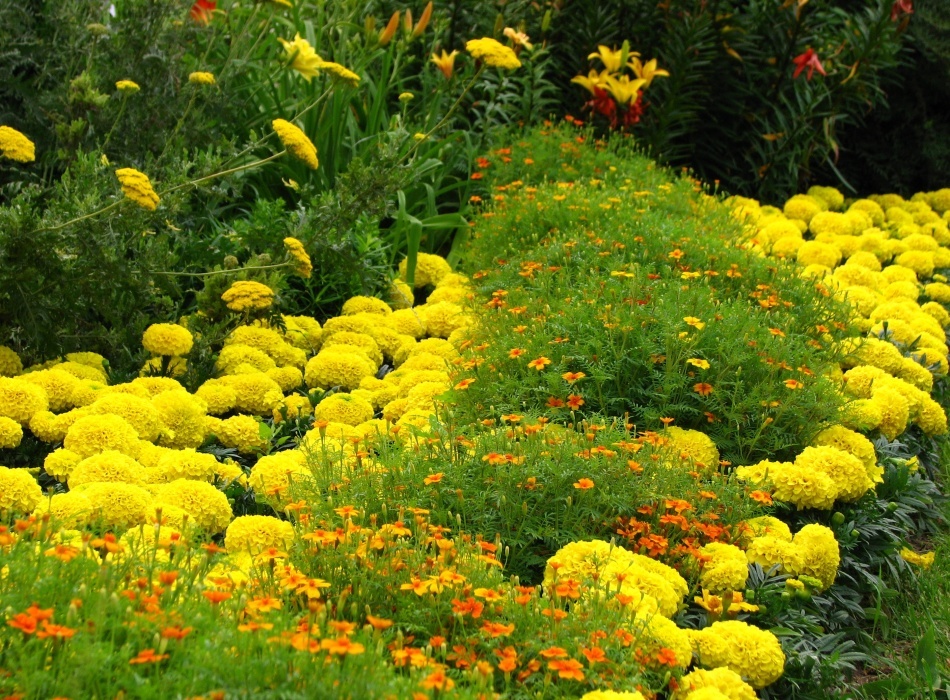 Marigolds of different varieties on the flowerbed near the house
Marigolds of different varieties on the flowerbed near the house By the way, very few people know that marigolds grow on our lands not so long ago. The first seeds were brought from Central America by conquistadors, so they appeared in Russia about the same time as tomatoes and potatoes. But on the American continent, the marigolds are still growing in the wild.
- The Indians made a potion from them, having drunk which the shaman could "communicate with spirits".Marigolds also treated various diseases and wounds, which, incidentally, was not groundless, because now the useful properties of the plant are studied and scientifically proven.
- Now these flowers are very popular in the east: in China and India. At the celebration of Diwali( the day of lights, which symbolizes the victory of good over evil) garlands of marigold adorn houses, a sacred cow and even dogs. More photos and information regarding the unusual use of these flowers in India can be found here.
- In the Mediterranean countries, marigolds. .. eat. To satisfy the needs of gourmets these flowers are sown whole fields
 Sacred cow with garland from marigolds
Sacred cow with garland from marigolds Species and varieties of marigolds: bolero, carmen, lemon, tall
There are three types of marigolds: erect, deflected and thin.
- Straight marigolds - rather large plants, grow to a height of 1o-130 cm. They have powerful stems, large leaves, and large flowers, from 7 to 15 cm in diameter.
- . The rejected marigolds look like a branchy bushes 50-60 cm high, strewnmany colors
- leaves of marigold marigolds are smaller, and the flowers consist of only five petals arranged in one row and small stamens
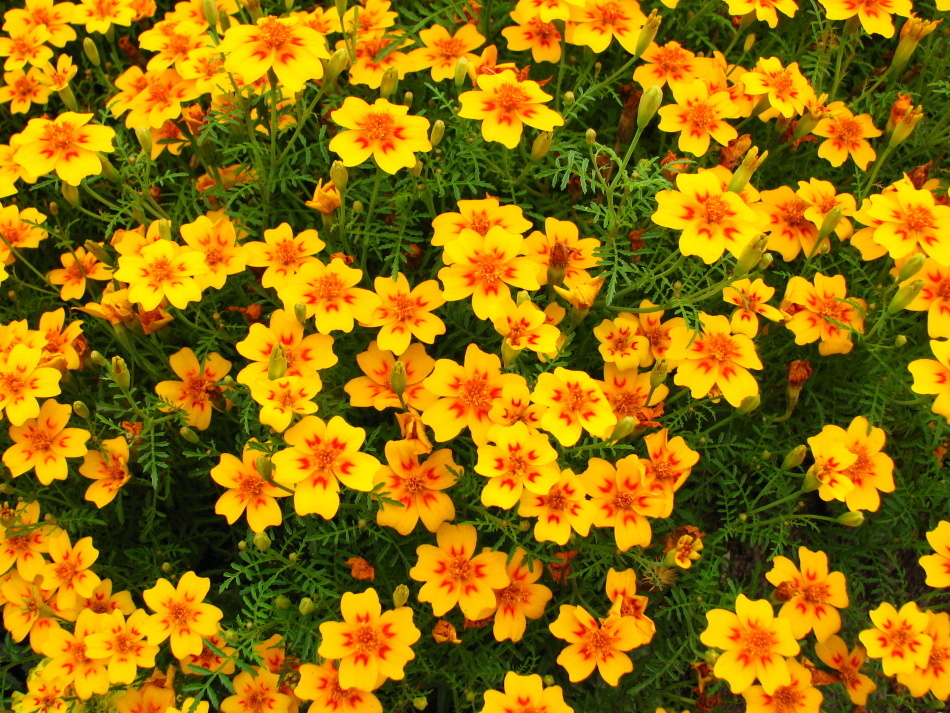 Exotic fine-leaf marigolds
Exotic fine-leaf marigolds Marigolds Bolero
More than 50 species of these flowers are known, Popular and favorite varieties of cultivators. Marigold Bolero is a classic plant species 15-20 cm high with lush inflorescences and wavy yellow-red petals. When it comes to marigolds, most people represent them. This variety refers to the species rejected by marigolds. Variety Bolero well tolerates penumbra and blooms after 1.5 months after emergence.
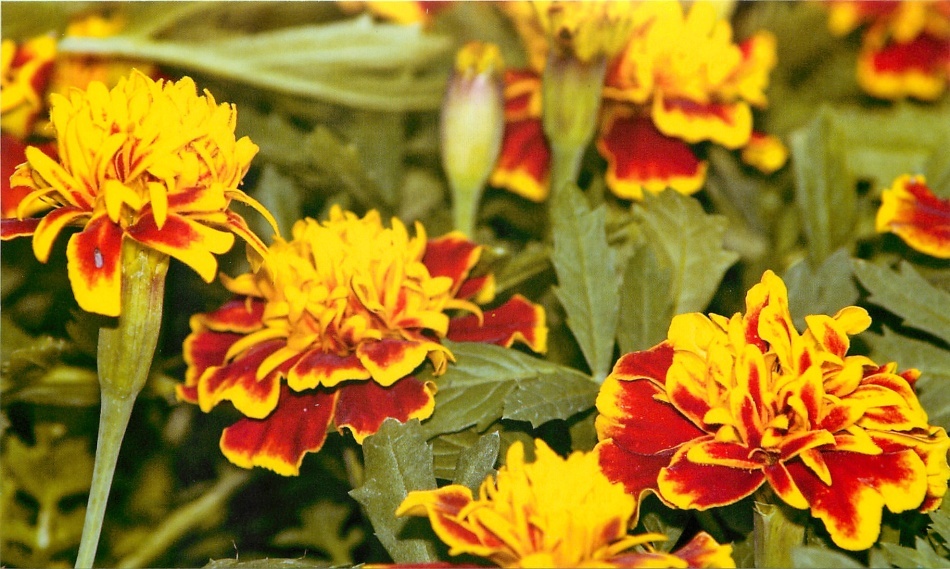
Such marigolds are unpretentious in their care, love sunlight, but can grow in the shade.
It is fair to say that there is a whole family of marigolds Bonaz , with flowers very similar to the Bolero variety. In particular, they are: marigolds Bikolor with darker petals, marigolds Bonanza Flame in color reminiscent of fire, marigolds Bonaza Pchelka , where on the contrary more red and less yellow and others. In addition, in stores you can buy packages with seeds of different varieties, which are called "Bonaz Meeks".
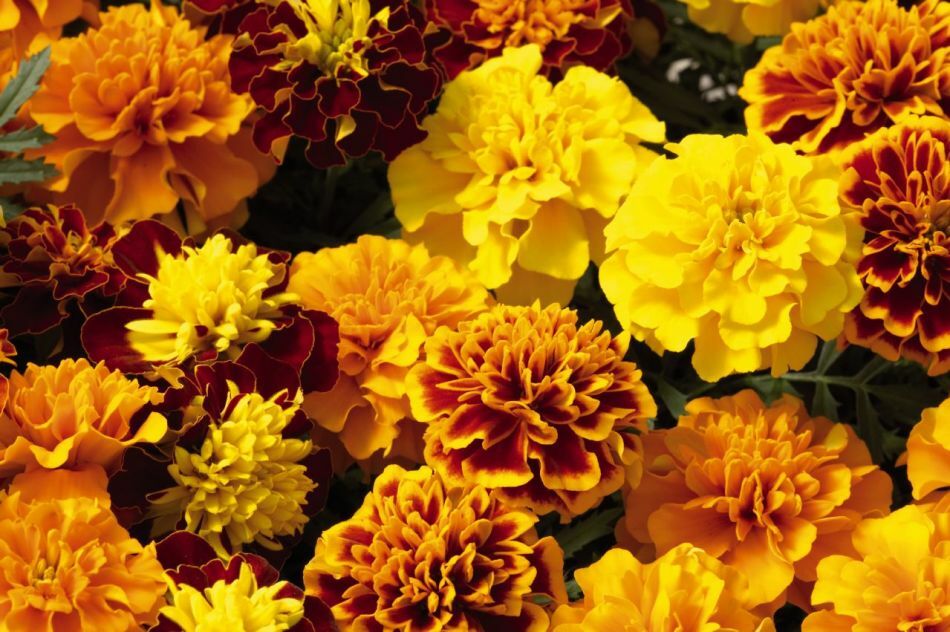 Different grades of rejected marigold mixed with
Different grades of rejected marigold mixed with Marigolds Carmen
Also apply to rejected marigolds. They have dark red petals and a yellow center with stamens. On the edge of the petals there is a thin yellow bezel. The height of the bush is up to 30 cm.
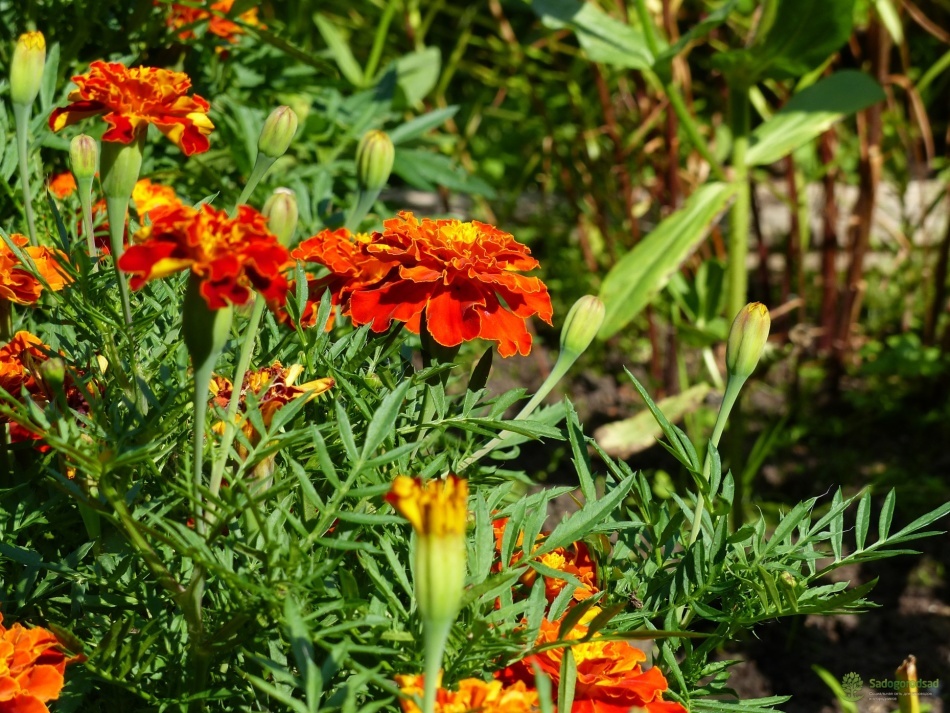 Marigolds Carmen
Marigolds Carmen This variety, like the Bolero variety, is unpretentious and does not require constant attention from the gardener.
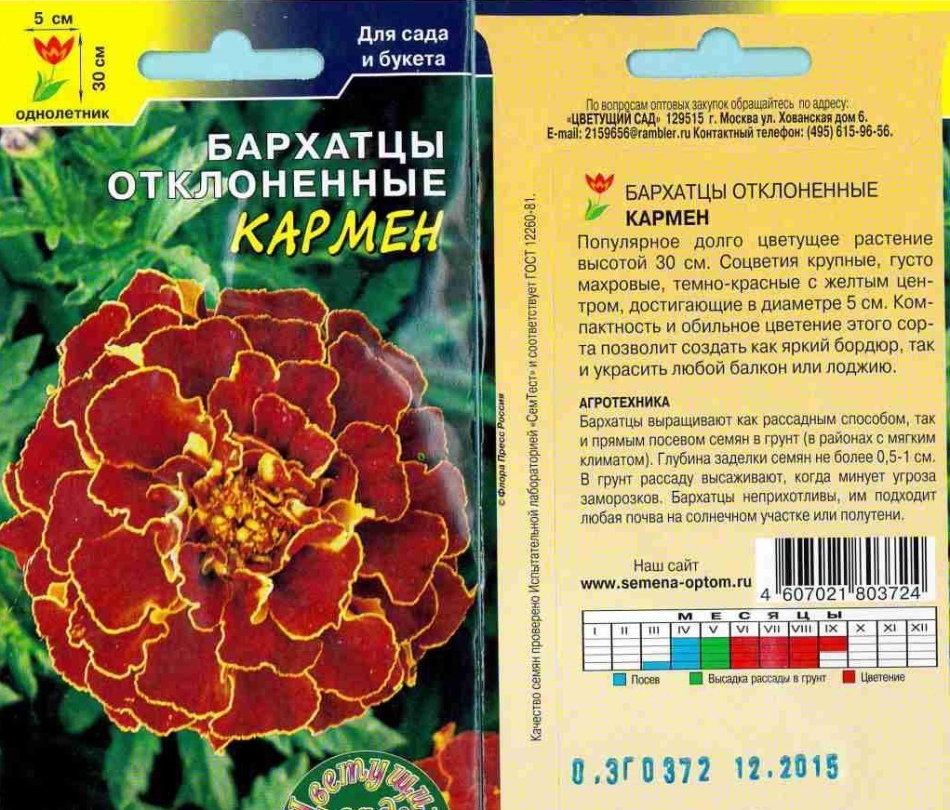 Packing of marigold seeds Carmen
Packing of marigold seeds Carmen The plant is undemanding to soils and abundant watering, but grows more powerful on light, fertile soils.
To blossom marigolds lasted longer, you need to tear off buds that have already faded
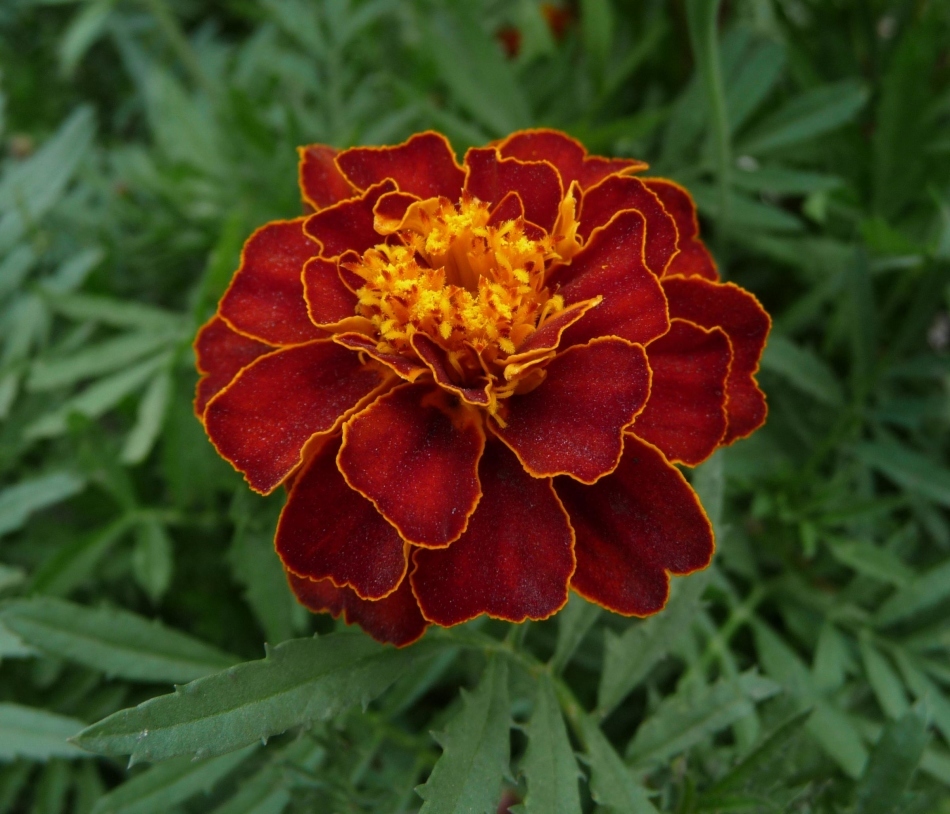 Marigolds Carmen
Marigolds Carmen Lemon marigolds
Those who like lemongrong marigolds will find many varieties on sale. Such as Lemon Miracle, Yellow Toddler, Golden Age, Moonlight, Sunny and others.
 Packing of marigold seeds Lemon Miracle
Packing of marigold seeds Lemon Miracle Lemon marigolds look good in a single-colored flower bed, but you can show your imagination and make a flower bed with interspersed flowers of other species.
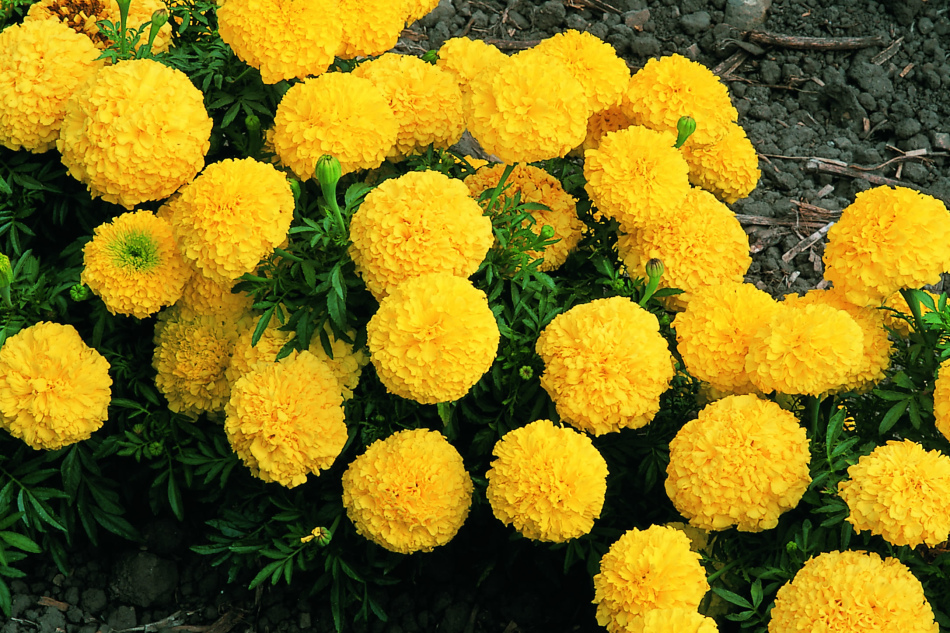 Low-grown lemon marigolds
Low-grown lemon marigolds Tall marigolds
Tall marigolds grow to a height of 100-130 cm. They look good in combination with more miniature flowers, if you plant high flowers in the center and low on the edge of the flowerbed.
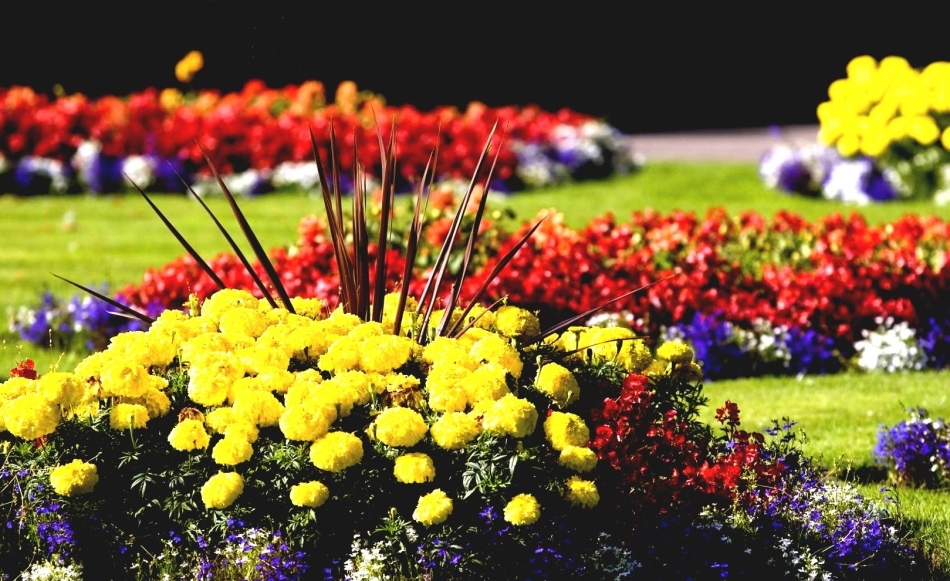 Tall marigolds
Tall marigolds Marigold growing out of seeds at home
- It is believed that the optimal time for planting seeds in open ground is beginning of May .After all, for rapid emergence of sprouts, the air temperature should be from 20 to 24 degrees
- The earth is desirable to be moderately moist
- For planting, make a trowel furrow about 5 cm deep, pour the ground with water and evenly sprinkle the seeds, then again pour the furrow on the ground.
- Shoots appear through3 - 10 days, depending on the ambient temperature
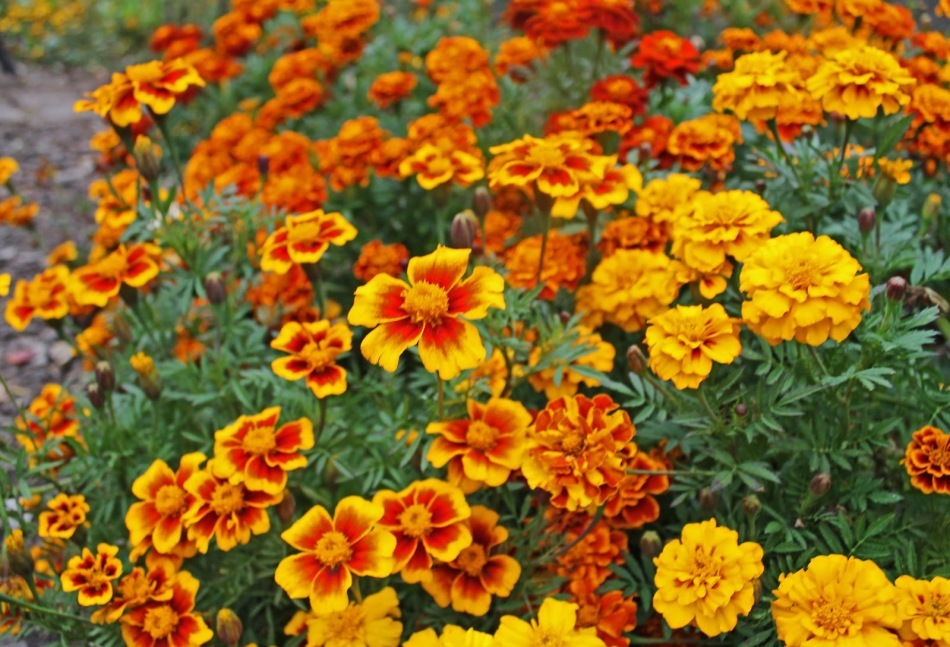 Marigolds love the heat and light
Marigolds love the heat and light In cold earth, seeds can die or germinate very long. Therefore, after the appearance of sprouts, it is necessary to provide enough marigolds of light and moisture. The earth does not need to be waterlogged to avoid the appearance of fungal diseases and water the seedlings when the land is completely dry.
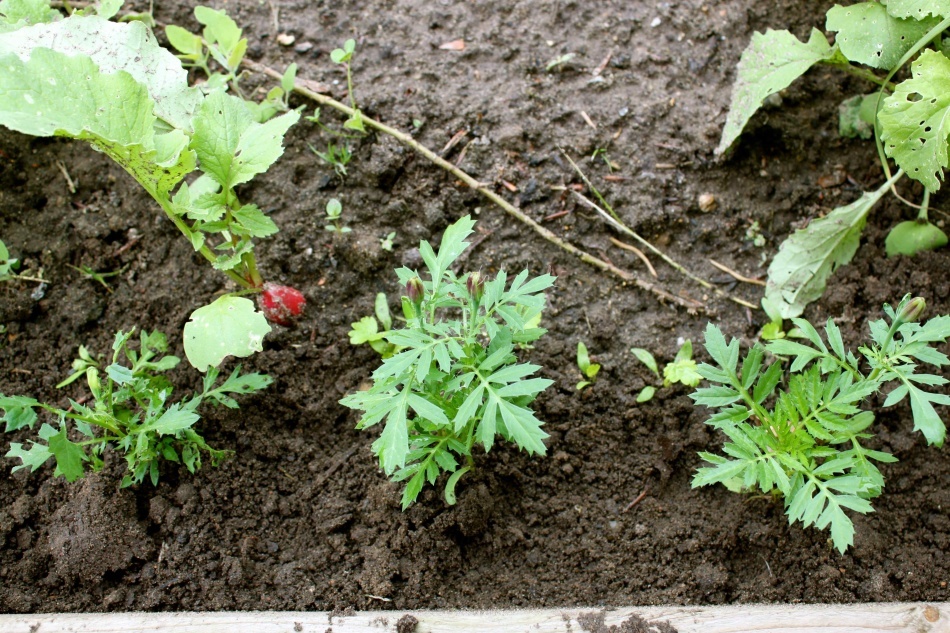 Marigolds sown in open ground
Marigolds sown in open ground When to plant marigolds on seedlings?
- Earlier it is necessary to plant tall marigolds on seedlings, it is recommended to plant them in pots in the middle of March.
- . Deviated and fine-leaved marigolds sow in early April.
If all these marigolds are blossoming simultaneously, in early June. If you live in a region with a warm climate and want the marigolds to blossom earlier, you can independently adjust the seeding time for the seedlings.
Remember that marigolds die at an air temperature below minus 2 ° C, so it is advisable to drop them when the threat of frost has finally passed.
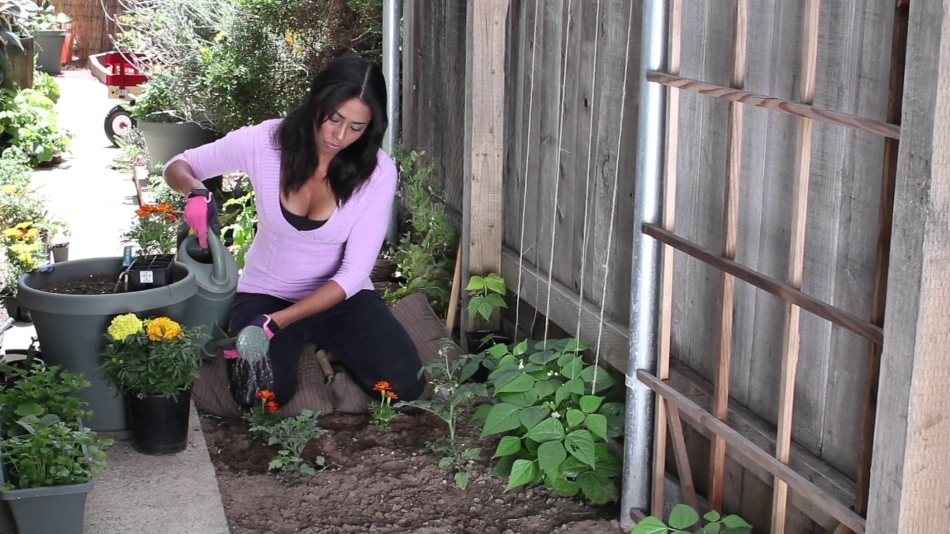 Seedling of marigold seedlings in open ground
Seedling of marigold seedlings in open ground Seeds of marigolds are rather large and they can be immersed in the earth to a depth of 0.5-1 cm. If you sow them in pots, then it is better to use ready-made universal soil mixtures for seedlings. You can mix these mixtures in a 1: 1 ratio with the ground.
To prevent moisture, pots should have good drainage in the pots
 Seedlings of marigolds
Seedlings of marigolds When to plant marigolds in open ground?
Seedlings of marigolds are recommended to be planted in the open ground at the age of 1 month .Therefore, it is necessary to sow seeds 1 month before planting, plus from three to ten days for germination of seeds.
You can also increase the time spent in the pots, but in this case the plants should be provided with additional fertilizing and sufficient light. The marigolds stretched from lack of light do not get well and fall behind in growth.
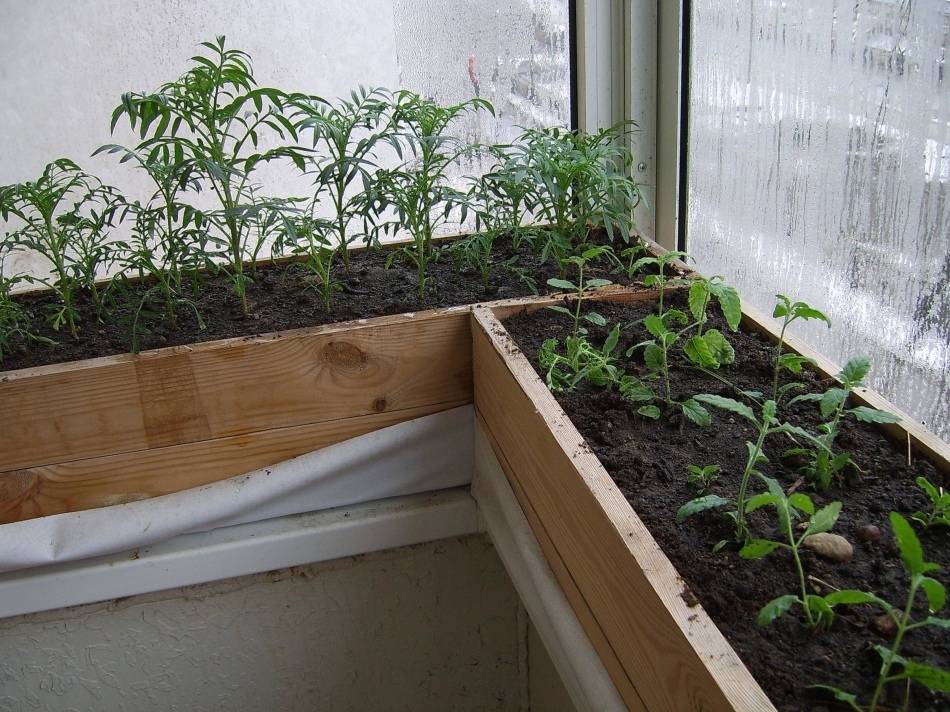 Extruded from lack of light seedlings
Extruded from lack of light seedlings When to dive marigolds after sprouting?
Do gardeners do not have an unequivocal opinion on whether it is worth diving seedlings in general and seedlings of marigolds in particular.
- On the one hand, when the seedlings are dived( transplantation from a smaller capacity to a larger one), the root system of the plant always suffers, which affects it negatively.
- On the other hand, there is more space for root growth, and therefore the plant should grow faster.
Thus, dive marigoldsit makes sense only if you get too thick shoots. If you initially sowed seeds 3-4 pieces in a plastic pot, then there is no need for this.
The best time to dive is when the first two real "carved" leaves appear on the sprout( two oval leaves that grow even earlier than they count).It should be noted that marigolds are a relatively unpretentious plant, and they usually tolerate transplantation well.
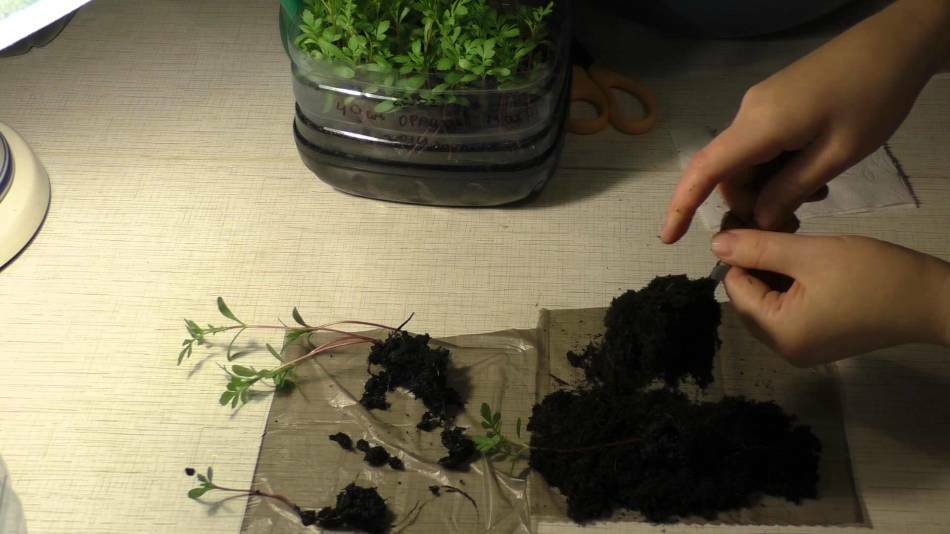 In some pots, marigold seedlings grow faster
In some pots, marigold seedlings grow faster When and how to fertilize marigolds?
Fertilize the marigold is not necessary, they will please the rapid growth and lush flowering and so on. But if you decide to feed them, they will be grateful for it. Most need fertilizers for plants that grow in closed containers: boxes or vases.
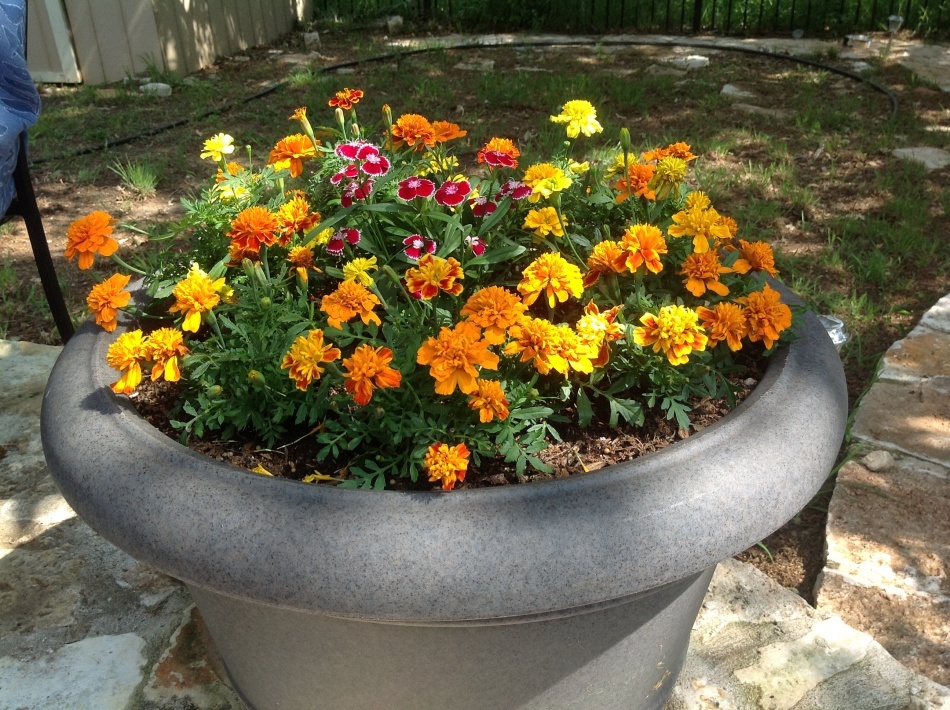 Marigolds in the
Marigolds in the flower pot Before planting in a pot or planting in an open ground, the ground can be mixed with mineral fertilizer, which is popularly called Amofo or nitroamophic.
Warning! Do not try to stir these fertilizers in water, then to water the flowers. Capsules simply do not dissolve
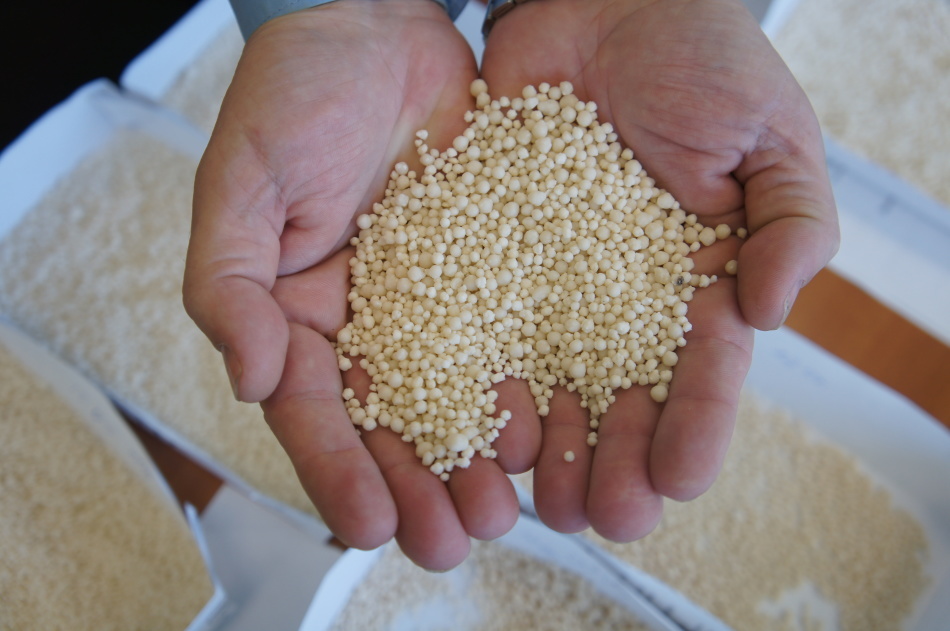 Dry mineral fertilizers
Dry mineral fertilizers To feed already planted marigolds, any mineral fertilizers for flowers that are sold in liquid form and contain: nitrogen, potassium and phosphorus .
Do not apply fertilizer often, because of this, the bushes will strongly go into growth, but will bloom later. Fertilize marigolds should be only three times per season:
- When the height of seedlings will be equal to 10-12 cm
- When the buds of
- appear When marigolds first blossom
In addition to please marigold you can take care of the quality of the soil.
- These flowers do not like heavy clay soils, so it is advisable to mix the ground with peat or sand
- before planting. Also, it is necessary to loosen the soil when a crust forms on it, because marigolds are very important for the roots to receive enough oxygen.
- . To prevent drying, it is advisable to fill up the areas near the flowersstraw
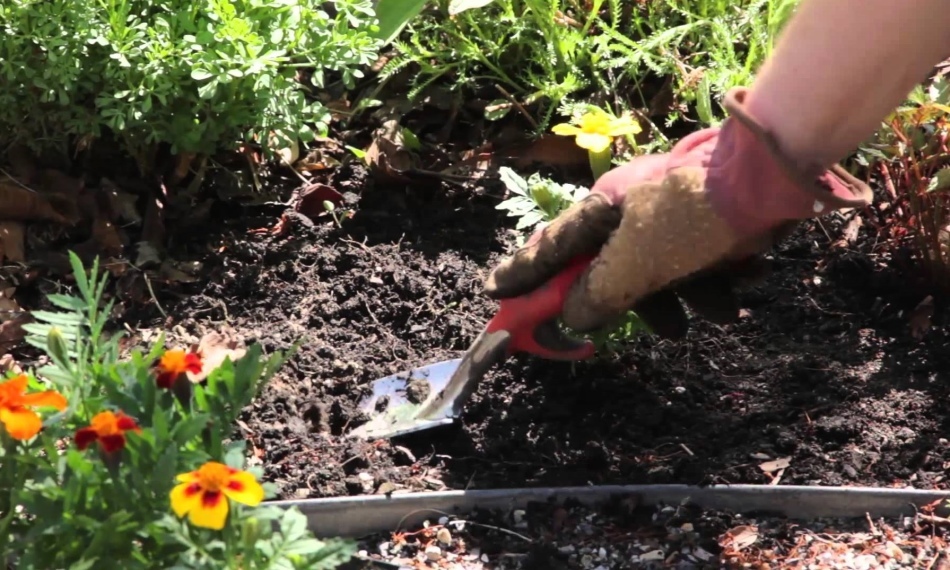 Soil around the marigold should be loose
Soil around the marigold should be loose Diseases and pests of marigolds
Marigolds excrete aromatic substances into the air, due to which no insect pestsnot scary. Moreover, planting marigolds near other plants can be protected from pests and them, some gardeners do just that.
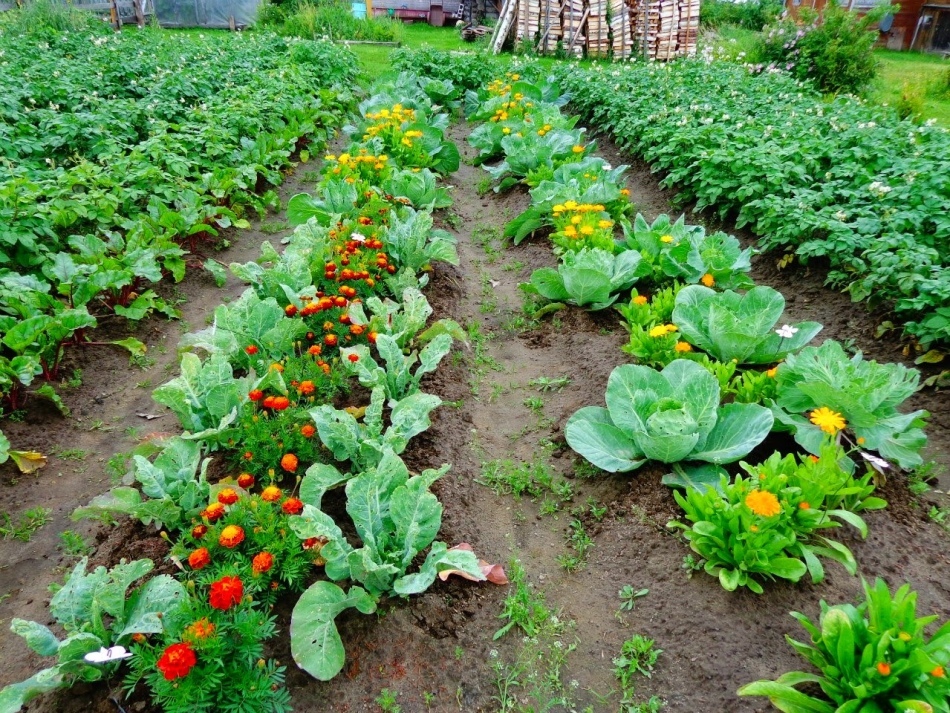 Marigolds protect cabbage
Marigolds protect cabbage All problems that can appear in marigolds are caused only by unfavorable external environment: sometimes mold appears from cold and high humidity, and in case of extreme heat and lack of watering, spider mites can settle on bushes.
 Marigold diseases caused by high humidity
Marigold diseases caused by high humidity - If marigolds are affected by mold should make watering more moderate and ensure conditions for the land to dry more quickly: thin out the plants if they are planted too thickly and remove the most affected fungi
- To combat the spider mites is also simple enough to eliminate the cause of its appearance: pour marigolds and sprinkle leaves with ordinary water( these mites do not tolerate high humidity).You can use special tools for sprinkling, for example, Aktellik, Fitoverm, Neoron
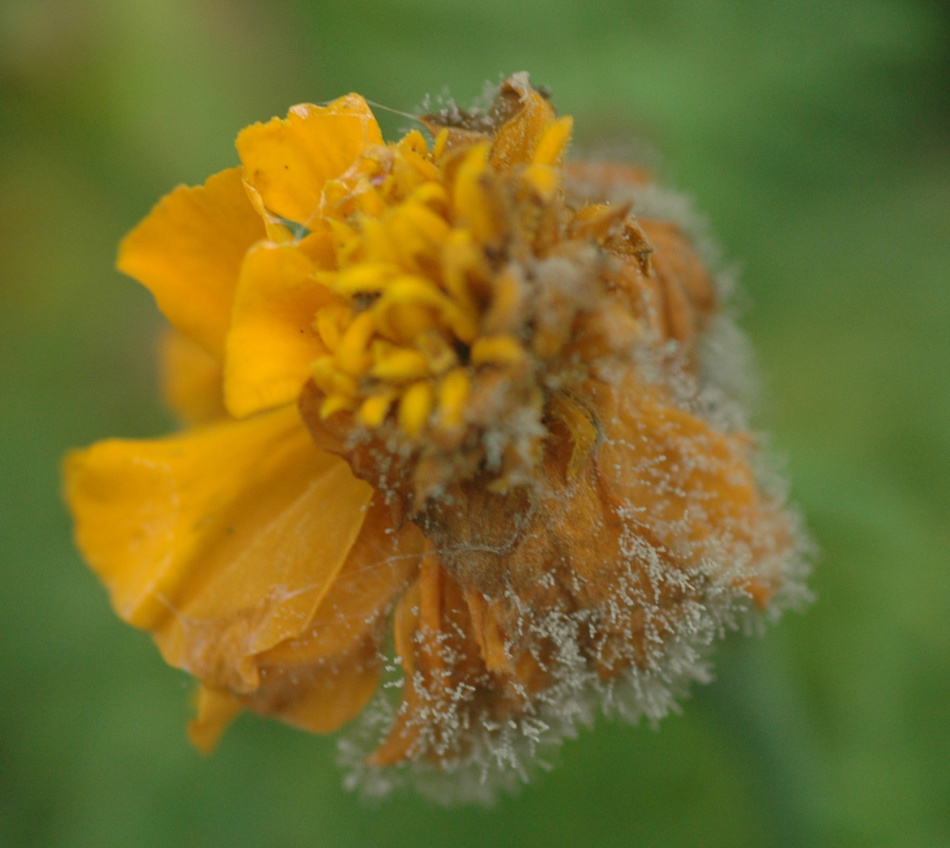 Spider mite on a flower
Spider mite on a flower If you grow marigold yourself - then you can receive a truly tremendous pleasure. No matter where your flowers grow - on a huge flower bed, a small patch of earth or a window sill.
If you put your soul and heart into your plants, they will thank you with the green leaves, bright colors and unearthly aroma. Many like marigolds for unpretentiousness and endurance of plants, beautiful flowers and a pleasant, spicy aroma.
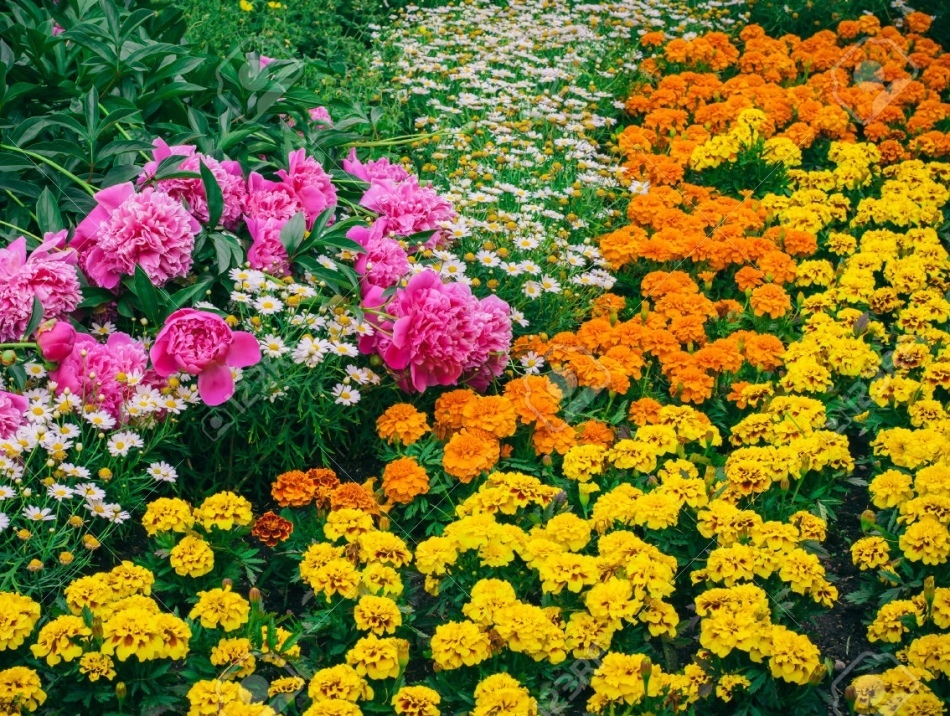 Marigolds on the flower bed
Marigolds on the flower bed 